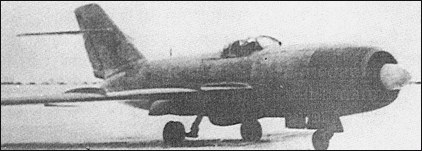|
| Designed to meet a requirement formulated in 1948 for
a two-seat twin-engined all-weather interceptor, the
La-200 was flown for the first time on 9 September 1949. Two prototypes were built, each powered by two 2700kg Klimov VK-1 turbojets mounted
in tandem with the exhaust of the foremost engine
ducted beneath the fuselage. The prototypes differed
one from the other primarily in the location of the Torii
(Thorium) AI radar, the first prototype having a conical
intake centrebody and the second prototype having a
radome underslung on the upper intake lip. Armament
consisted of three 37mm N-37 cannon, one to port and
two to starboard. The wing, sweptback 40° at the
leading edge, was largely occupied by integral tankage
and two large underwing slipper-type auxiliary tanks
could boost maximum range from 1165 to 2000km.
The first prototype was flown on 9
September 1949, and the first and second flight test
phases were completed by February and October 1950
respectively, Mach=0.946 being attained in level flight
and Mach=1.01 in a dive. The second prototype joined
the flight programme early 1951, the repositioned radar
being of the improved Torii-A type, ammunition capacity
being increased, a ventral keel being introduced
and normal loaded weight rising to 10580kg. With the final NII VVS test phase completed
in April 1951, a recommendation was made that series
production of the La-200 should be initiated. This was
thwarted, however, by the issue of a replacement specification
in November 1951 calling for a substantial increase
in range to permit all-weather standing patrols,
and for the provision of heavier, longer-ranging radar. Further work on the La-200 was therefore discontinued
in favour of the revised La-200B.

| MODEL | La-200 (1st prototype) |
| WEIGHTS |
| Take-off weight | 10375 kg | 22873 lb |
| Empty weight | 7090 kg | 15631 lb |
| DIMENSIONS |
| Wingspan | 12.92 m | 42 ft 5 in |
| Length | 16.59 m | 54 ft 5 in |
| Wing area | 40.18 m2 | 432.49 sq ft |
| PERFORMANCE |
| Max. speed | 1090 km/h | 677 mph |
| Range | 1165 km | 724 miles |
 | A three-view drawing of La-200, the second prototype (1647 x 1137) |
| bombardier, e-mail, 23.05.2011 14:29 One of the ugliest Soviet aircraft ever built reply |
|
Do you have any comments?
|
| 
COMPANY
PROFILE
All the World's Rotorcraft
|








